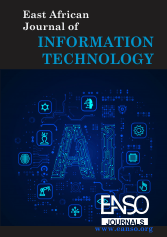A Smart IoT-Based Real-Time System for Monitoring Storage Conditions of Maize Grains
Abstract
Maize is a cereal with many uses across the world. In developing countries, it is valued for its dried cereal, which has been used as a stable source of food. This cereal may be boiled and eaten as it is or may be dried and ground and made into porridge or Ugali, a popular carbohydrate source. The storage of maize grains is critical to ensuring food security and preventing post-harvest losses due to spoilage, pest infestation, and unfavourable environmental conditions. Traditional storage monitoring methods entailed using support staff to visit storage areas and measure conditions using manual methods which are inefficient and labour-intensive, leading to delays in the detection of adverse storage conditions and spoilages. In this paper, an Internet of Things (IoT)-based real-time storage conditions monitoring system that leverages Long Range Wide Area Network (LoRaWAN) technology to enhance communication efficiency and data transmission over long distances with low power consumption is presented. The system consists of smart sensors deployed in maize storage facilities to collect environmental parameters such as temperature, humidity, and carbon dioxide (CO2) levels which are critical for maize storage. The collected data is transmitted via LoRaWAN to a cloud-based platform for real-time visualization, analysis and proactive detection of changing situations using Machine Learning (ML) techniques. This approach provides an efficient, scalable, and cost-effective solution for improving maize storage, especially in resource-constrained environments since it limits manual human intervention. In addition, the technology prevents losses due to fungal infections, resulting in adequate high-quality maize supply to curb hunger and improve livelihoods which is the second United Nations’ Sustainable Development Goals of alleviating hunger and achieving food security
Downloads
References
Agrawal, S. K. (2021). Metrics to Evaluate your Classification Model to take the right decisions. Analytics Vidhya. https://www.analyticsvidhya.com/blog/2021/07/metrics-to-evaluate-your-classification-model-to-take-the-right-decisions/
Angelovič, M., Krištof, K., Jobbágy, J., & Findura, P. (2018). (PDF) The effect of conditions and storage time on course of moisture and temperature of maize grains. BIO Web of Conferences. https://doi.org/10.1051/bioconf/20181002001
Boyko, N., Omeliukh, R., & Duliaba, N. (2022). The Random Forest Algorithm as an Element of Statistical Learning for Disease Prediction.
Daly, J., Hamrick, D., Geref, G., & Guinn, A. (2016). Maize Chains in East Africa. https://www.theigc.org/sites/default/files/2017/05/Daly-et-al-2017-Maize-paper.pdf
de Bruyn, M., Nel, A., & van Niekerk, J. (2024). The nutritional benefits of maize-soybean rotational systems in the North-Western Free State, South Africa. Agriculture & Food Security, 13(1), 20. https://doi.org/10.1186/s40066-024-00473-5
De Groote, H., Githinji, P. G., Munya, B. G., & Ricker-Gilbert, J. E. (2021). Economics of open-air sun drying in the maize value chain of Kenya. Journal of Agriculture and Food Research, 5, 100185. https://doi.org/10.1016/j.jafr.2021.100185
De Groote, H., Muteti, F. N., & Bruce, A. Y. (2023). On-farm storage loss estimates of maize in Kenya using community survey methods. Journal of Stored Products Research, 102, 102107. https://doi.org/10.1016/j.jspr.2023.102107
Doltade, A., Kadam, A., Honmore, S., Wagh, S., & B.Tech. (2019). Intelligent Grain Storage Management System based on IoT. https://www.semanticscholar.org/paper/Intelligent-Grain-Storage-Management-System-based- Doltade- Kadam/18205058e1cc4c41985a768d4923eb0dcf682e51
Dragino. (2024). Dragino: Products. https://www.dragino.com/products/products-list.html
Ekpa, O., Palacios-Rojas, N., Kruseman, G., Fogliano, V., & Linnemann, A. R. (2019). Sub-Saharan African Maize-Based Foods—Processing Practices, Challenges and Opportunities. Food Reviews International, 35(7), 609– 639. https://doi.org/10.1080/87559129.2019.1588290
Gupta, N., Singh, P., & Kaur, P. (2021). Wireless Sensor Network in Agriculture: Needs, Challenges and Solutions | Request PDF. ResearchGate. https://doi.org/10.1007/978-981-16-4149-7_52
Jerving, S. (2020, January 13). Kenyans love maize. But aflatoxins are making it dangerous. Devex. https://www.devex.com/news/sponsored/kenyans-love-maize-but-aflatoxins-are-making-it-dangerous-96279
Koresh, H. J. D. (2024). Impact of the Preprocessing Steps in Deep Learning-Based Image Classifications. National Academy Science Letters, 47(6), 645–647. https://doi.org/10.1007/s40009-023-01372-2
Lydia, J., Vimalraj, L. S., Monisha, R., & Murugan, R. (2022). Automated food grain monitoring system for warehouse using IOT - ScienceDirect. https://www.sciencedirect.com/science/article/pii/S2665917422001064
Nguyen, Q. H., Ly, H.-B., Ho, L. S., Al-Ansari, N., Le, H. V., Tran, V. Q., Prakash, I., & Pham, B. T. (2021). Influence of Data Splitting on Performance of Machine Learning Models in Prediction of Shear Strength of Soil. Mathematical Problems in Engineering, 2021, 1–15. https://doi.org/10.1155/2021/4832864
Pocero, L., Tsampas, S., Mylonas, G., & Amaxilatis, D. (2020). (PDF) A Comparative Study of LoRa and IEEE 802.15.4-based IoT Deployments inside School Buildings. ResearchGate. https://doi.org/10.1109/ACCESS.2020.3020685
Ranum, P., Peña‐Rosas, J. P., & Garcia‐Casal, M. N. (2014). Global maize production, utilization, and consumption. Annals of the New York Academy of Sciences, 1312(1), 105–112. https://doi.org/10.1111/nyas.12396
Sajjad, M., Talpur, H., Khan, S., Oad, A., Sarwar, R., Soomro, A. H., Rehman, H., Talpur, F., Luhrani, A., Talpur, S. H., & Saba, E. (2021). IoT Based Grain Storage Monitoring with Android Application. International Journal of Advanced Trends in Computer Science and Engineering, 10(2), 1356– 1361. https://doi.org/10.30534/ijatcse/2021/1231022021
Sharma, K., & Shivandu, S. K. (2024). Integrating artificial intelligence and Internet of Things (IoT) for enhanced crop monitoring and management in precision agriculture. Sensors International, 5, 100292. https://doi.org/10.1016/j.sintl.2024.100292
Tsang, Y. P., Choy, K. L., Poon, T. C., Ho, G. T. S., Wu, C. H., Lam, H. Y., Koo, P. S., & Ho, H. Y. (2016). An IoT-based Occupational Safety Management System in Cold Storage Facilities. Proceedings of the 6th International Workshop of Advanced Manufacturing and Automation. 6th International Workshop of Advanced Manufacturing and Automation, Manchester, UK. https://doi.org/10.2991/iwama-16.2016.2
UN. (2025). THE 17 GOALS | Sustainable Development. https://sdgs.un.org/goals
Velos. (2024, July 5). Precision Farming—IoT Applications in Agriculture. https://blog.velosiot.com/precision-farming-iot-applications-in-agriculture
Viviane, I., Masabo, E., Joseph, H., Rene, M., & Bizuru, E. (2023). IoT-Based Real-Time Crop Drying and Storage Monitoring System. International Journal of Distributed Sensor Networks, 2023(1), 4803000. https://doi.org/10.1155/2023/4803000
World Vision. (2023). Africa hunger crisis: Facts, FAQs, how to help | World Vision. https://www.worldvision.org/hunger-news-stories/africa-hunger-famine-facts
Copyright (c) 2025 Everleen Nekesa Wanyonyi

This work is licensed under a Creative Commons Attribution 4.0 International License.




























